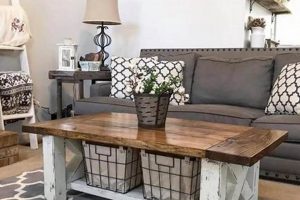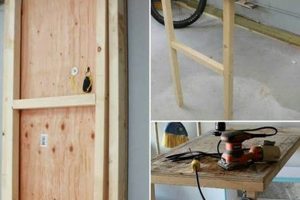A shop-made auxiliary tool designed to safely guide material through a table saw. It provides a secure point of contact, keeping hands away from the blade during ripping operations, especially when working with narrow stock. Functionally, it acts as an extension of the users hand, enabling controlled pressure and movement throughout the cut. This safeguarding device can be crafted from various materials like plywood, hardwood, or even plastic, tailored to specific tasks and preferences.
Its use is paramount for operator safety and precision. It significantly reduces the risk of kickback and accidental contact with the blade, mitigating potential injuries. Historically, woodworkers have employed similar devices for centuries to enhance control and safety when using saws. Today, it represents an essential safety measure in any woodworking shop, promoting accurate cuts and fostering a safer work environment. Its implementation often contributes to improved project quality and decreased material waste.
The following sections will delve into the various design considerations, material selection, and construction techniques for creating effective versions of this important tool. Further examination will cover the practical application, maintenance, and storage practices to ensure its longevity and continued effectiveness as a safety component. Finally, the article will touch on advanced designs and specialized adaptations for unique sawing challenges.
Essential Tips for Fabricating a Table Saw Push Stick
The effective creation and utilization of a shop-made auxiliary tool for table saw operation hinges on several key considerations. The following tips aim to provide guidance for constructing durable and safe tools.
Tip 1: Material Selection: Opt for dense, stable materials like hardwood or Baltic birch plywood. Avoid softwoods, as they can splinter easily and compromise the tool’s integrity. The chosen material should resist deformation under pressure.
Tip 2: Ergonomic Design: Prioritize a comfortable and secure grip. Design the handle to allow for a firm hold without causing strain. Consider the shape and orientation of the handle relative to the push surface.
Tip 3: Adequate Clearance: Ensure the push stick provides sufficient clearance between the operator’s hand and the saw blade. A longer push stick is generally safer, especially when working with smaller or narrower stock.
Tip 4: Non-Slip Surface: Apply a non-slip coating or adhesive grip to the pushing surface. This feature will prevent the material from slipping during the cutting process, promoting consistent and controlled movement.
Tip 5: Durable Construction: Employ strong joinery techniques, such as mortise and tenon or rabbet joints, to ensure the push stick’s structural integrity. Secure all components with high-quality adhesives and fasteners.
Tip 6: Consider Replaceable Components: Design the tool so that the leading edge (the portion that contacts the workpiece) can be easily replaced when it becomes worn or damaged. This extends the life of the tool.
Tip 7: Dedicated Storage: Establish a designated storage location for the push stick when not in use. This prevents damage and ensures it is readily accessible when needed, promoting consistent use.
Adhering to these tips contributes significantly to the functionality and safety of table saw operations. A well-constructed safeguarding device not only protects the operator but also enhances the precision and quality of the work produced.
In the subsequent sections, we will examine advanced design modifications and specialized versions of this tool, catering to specific woodworking applications.
1. Material Selection
Material selection exerts a direct and significant influence on the functionality, durability, and, most importantly, safety of a shop-made safeguarding device for table saws. The chosen material dictates the tool’s resistance to wear, its structural integrity under pressure, and its potential to contribute to hazardous situations. For instance, utilizing a softwood such as pine for construction will result in a tool prone to splintering under stress. This splintering presents a hazard, as loose fragments could become projectiles or compromise the user’s grip, leading to loss of control and potential injury. Conversely, employing a dense hardwood like maple or a multi-ply laminate such as Baltic birch plywood significantly enhances the tool’s resistance to wear and tear, ensuring a more reliable and safer operating experience.
The material’s density and grain structure directly impact the ability to maintain a firm and consistent pressure against the workpiece being fed into the saw blade. A material with excessive flex or a coarse grain may lead to uneven pressure, causing the workpiece to bind or chatter, increasing the risk of kickback. Similarly, resistance to moisture and dimensional stability are critical. Materials prone to warping or swelling with humidity fluctuations can alter the tool’s shape and potentially interfere with its intended function, creating unsafe operating conditions. An example of this is using unsealed MDF or particle board, which will absorb moisture and deform, rendering the tool ineffective.
In summary, careful consideration of material properties is paramount when constructing a table saw safeguarding device. The selection should prioritize materials exhibiting high strength, dimensional stability, and resistance to splintering or degradation under typical workshop conditions. Choosing the appropriate material contributes directly to improved safety, enhanced tool longevity, and ultimately, more precise and controlled woodworking operations. The challenge lies in balancing material cost with performance requirements to achieve an optimal and safe working solution.
2. Ergonomic Design
Ergonomic design principles are critically important when constructing a shop-made auxiliary tool for table saw operation. The tool’s ergonomics directly affect user comfort, control, and, most significantly, safety. A well-designed grip can minimize strain and maximize force transmission, while poor design can lead to fatigue, slippage, and increased risk of injury.
- Grip Configuration
The grip configuration encompasses the shape, size, and texture of the handle. It influences the user’s ability to maintain a secure hold. A handle that is too small can cause cramping, while one that is too large may prevent a firm grasp. Contoured grips that conform to the hand’s natural shape, similar to those found on professional hand tools, enhance comfort and reduce fatigue. Textured surfaces, such as knurling or the application of non-slip coatings, prevent slippage, even when hands are sweaty or oily. The appropriate grip configuration directly translates to increased control and reduced risk of losing contact with the push stick during use.
- Force Transmission Efficiency
The design should facilitate efficient transfer of force from the user’s hand to the workpiece. A poorly positioned or angled handle can require awkward wrist movements, reducing the amount of force that can be applied effectively. Orienting the handle in line with the direction of push minimizes wrist strain and maximizes force transmission. This is particularly important when working with dense or thick materials that require significant pressure to move through the saw blade. Efficient force transmission reduces the effort required and enhances control, contributing to safer and more precise cuts.
- Reduction of Fatigue
Extended use of a poorly designed push stick can lead to fatigue in the hand and wrist. Fatigue impairs judgment and reduces reaction time, increasing the risk of accidents. Ergonomic designs that minimize strain and maximize comfort contribute to reduced fatigue. Lightweight materials, balanced weight distribution, and comfortable grip configurations are crucial for minimizing the physical demands on the user. A less fatiguing tool allows for sustained focus and control, promoting a safer and more productive work environment.
- Hand Protection Integration
The ergonomic design can incorporate features that directly protect the user’s hand from potential hazards. For instance, a guard or shield positioned above the handle can prevent the hand from accidentally contacting the blade. The overall design should ensure adequate clearance between the hand and the blade, minimizing the risk of injury in the event of a slip or kickback. Prioritizing hand protection in the ergonomic design is a critical component of a safe and effective push stick.
In summary, thoughtful integration of ergonomic principles into the design of a safeguarding device is essential for promoting user safety and enhancing work quality. By focusing on grip configuration, force transmission efficiency, fatigue reduction, and hand protection, a shop-made push stick can become a valuable and safe tool for table saw operations. The long-term benefits of ergonomic design extend beyond immediate safety, contributing to increased productivity and reduced risk of repetitive strain injuries.
3. Blade Clearance
Blade clearance, within the context of a shop-fabricated auxiliary table saw tool, refers to the spatial relationship between the operator’s hand and the saw blade. It is a critical safety parameter, directly influencing the risk of injury during sawing operations. Insufficient clearance elevates the potential for accidental contact, while adequate clearance provides a margin of safety.
- Push Stick Length and Hand Position
The overall length dictates the minimum distance between the hand holding the tool and the spinning blade. A shorter device necessitates the hand being closer, increasing the risk of accidental contact, particularly during kickback events. Conversely, a longer device allows the hand to maintain a safer distance. The hand should remain behind the blade at all times, never directly above or to the side. The tool must be long enough to complete the cut safely without the user needing to reposition their grip closer to the blade during the final stages of the operation. Designs incorporating hand guards or widened handles further enhance this element of protection.
- Vertical Clearance Above the Workpiece
This aspect concerns the space between the top of the workpiece and the bottom of the hand holding the tool. Adequate vertical clearance is essential to prevent the hand from inadvertently contacting the rising blade, especially when working with thicker stock. The height of the tool, including the handle, must be sufficient to maintain a safe distance. The ergonomic design, specifically the handle’s shape and placement, contributes significantly to ensuring adequate vertical distance. Modifications like adding a riser to the handle effectively increase this clearance, minimizing the potential for hand-to-blade contact.
- Lateral Clearance from the Blade’s Cutting Path
This dimension describes the distance between the sides of the hand and the blade’s path. It’s essential to ensure the hand is not directly aligned with the blade’s cutting trajectory. Even a slight deviation from a straight pushing motion could bring the hand dangerously close to the blade. Tool designs often incorporate a wider body or a guiding fence to help maintain a safe lateral distance. Furthermore, the design can incorporate a physical barrier or guard to provide added protection, preventing the hand from inadvertently drifting into the blade’s path.
- Consideration for Different Blade Heights and Stock Thicknesses
The effectiveness of a safeguarding device is contingent on adapting to varying blade heights and stock thicknesses. A design that provides sufficient clearance for a thin board and a low blade setting might prove inadequate when cutting thicker material with a raised blade. Adjustable or interchangeable components enhance the versatility of a tool, allowing it to be adapted to diverse cutting scenarios. A universal design providing ample clearance regardless of material thickness or blade height setting offers optimal safety.
Therefore, blade clearance is a paramount safety factor. Careful consideration of length, vertical and lateral dimensions, and adaptability to various blade settings is essential to minimize injury risk when employing a shop-made tool for table saw operations. Prioritizing blade clearance enhances user safety, promotes consistent results, and contributes to overall confidence when operating a table saw.
4. Grip Security
Grip security is paramount in the design and utilization of a shop-fabricated auxiliary device for table saw operation. Consistent and reliable contact between the user’s hand and the device is essential for maintaining control during cutting operations. Any compromise in grip security increases the risk of slippage, loss of control, and potential injury.
- Surface Texture and Material
The surface texture of the handle directly affects the coefficient of friction between the user’s hand and the device. Smooth surfaces, particularly when wet or oily, offer minimal resistance, increasing the likelihood of slippage. Conversely, textured surfaces, such as knurling, rubberized coatings, or strategically placed sandpaper, significantly enhance grip security. Material choice also plays a crucial role. Materials that readily absorb moisture or become slippery when exposed to common workshop substances should be avoided. For instance, untreated smooth plastic offers poor grip security compared to textured hardwood or rubber-coated metal.
- Grip Shape and Ergonomics
The shape of the grip must conform to the natural contours of the hand to facilitate a secure and comfortable hold. Cylindrical grips, while simple to manufacture, often lack the ergonomic features necessary for optimal grip security. Contoured grips, designed to fit the hand’s curvature and finger placement, distribute pressure more evenly and reduce the risk of slippage. Angled grips can also improve wrist alignment, reducing strain and enhancing control. Proper ergonomic design ensures the user can maintain a firm grasp without excessive force, minimizing fatigue and improving overall grip security.
- Moisture Management
Perspiration and other forms of moisture can significantly reduce grip security. Designs that incorporate features to manage moisture, such as ventilated grips or absorbent materials, can improve contact in humid conditions or during extended use. For example, perforated rubber or strategically placed channels can wick away moisture, maintaining a secure grip even when hands are damp. The selection of materials that resist moisture absorption is also critical. Untreated wood, for example, can become slippery when wet, while certain synthetic materials offer superior moisture resistance and grip performance.
- Glove Compatibility
Many woodworkers utilize gloves for enhanced safety and protection. The design should accommodate the use of gloves without compromising grip security. Oversized grips may be necessary to accommodate gloved hands, and the surface texture must provide sufficient friction even when gloves are worn. Certain glove materials, such as leather or nitrile, offer superior grip performance compared to others. The tool design should be tested with various types of gloves to ensure compatibility and maintain a reliable and secure grip in a range of operating conditions.
The facets of surface texture, grip shape, moisture management, and glove compatibility collectively contribute to the overall grip security of a shop-fabricated auxiliary device for table saw operations. Careful consideration of these factors is essential to minimize the risk of slippage and loss of control, thereby enhancing user safety and improving the quality of work performed. Implementing robust grip security features is a fundamental aspect of responsible design and construction.
5. Construction Integrity
Construction integrity, in the context of a shop-fabricated auxiliary tool for table saw operation, denotes the structural soundness and resilience of the device. It encompasses the materials used, the joinery techniques employed, and the overall robustness of the tool’s assembly. A tool lacking adequate construction integrity poses a significant safety risk to the operator.
- Material Strength and Durability
The materials used must withstand the forces exerted during normal operation. This includes pressure applied to the workpiece, resistance from the saw table, and potential impacts from kickback events. Weak or brittle materials, such as low-grade particleboard, are prone to failure under stress, compromising the tool’s effectiveness and potentially creating hazardous projectiles. High-density hardwoods or multi-ply plywoods offer superior strength and resistance to deformation, ensuring the tool maintains its structural integrity over prolonged use. An example would be using Baltic birch plywood instead of pine for the body of the tool.
- Joinery Techniques and Fasteners
The methods used to join the various components of the tool are critical to its overall stability. Simple butt joints, relying solely on adhesive, are inherently weak and susceptible to separation. More robust joinery techniques, such as mortise and tenon joints, rabbet joints, or dadoes, provide a significantly stronger connection between components. Mechanical fasteners, such as screws or bolts, further enhance the strength and durability of the assembly. Fasteners should be appropriately sized and spaced to distribute stress effectively. As an example, a handle attached with screws and glue is preferable to one simply glued to the body of the tool.
- Adhesive Selection and Application
Adhesives play a crucial role in reinforcing joints and preventing component separation. The adhesive must be compatible with the materials being joined and capable of withstanding the forces exerted during use. High-quality wood glues, such as polyvinyl acetate (PVA) or polyurethane adhesives, offer excellent bond strength and resistance to moisture. Proper application of the adhesive is essential to achieve a strong and durable bond. Surfaces should be clean and free of contaminants, and sufficient clamping pressure should be applied during the curing process. An example of poor adhesion would be using hot glue on oily wood surfaces, resulting in a weak and unreliable bond.
- Resistance to Environmental Factors
The tool should be able to withstand the environmental conditions typically found in a woodworking shop. This includes fluctuations in temperature and humidity, as well as exposure to dust, solvents, and other chemicals. Materials that are prone to warping, swelling, or degradation when exposed to moisture or chemicals should be avoided. Applying a protective finish, such as varnish or polyurethane, can help to seal the tool and protect it from environmental damage. For instance, sealing an MDF push stick prevents moisture absorption and subsequent deformation.
These considerations highlight the critical role construction integrity plays in the safe and effective operation of a shop-fabricated table saw tool. Prioritizing material strength, robust joinery, appropriate adhesives, and resistance to environmental factors ensures the device maintains its structural soundness over time, providing a reliable and safe means of controlling workpieces during sawing operations.
Frequently Asked Questions
This section addresses common inquiries regarding the design, construction, and implementation of shop-fabricated auxiliary tools for table saw operation. The information provided aims to clarify best practices and mitigate potential misunderstandings.
Question 1: What constitutes an acceptable material for the fabrication of a shop-made push stick?
Acceptable materials should exhibit high strength, dimensional stability, and resistance to splintering. Dense hardwoods, such as maple or oak, and multi-ply laminates, such as Baltic birch plywood, are suitable choices. Softwoods, particleboard, and materials prone to cracking or deformation should be avoided.
Question 2: Is there a minimum length requirement for a shop-fabricated push stick?
While no absolute minimum length exists, the push stick must be sufficiently long to maintain a safe distance between the operator’s hand and the saw blade throughout the entire cutting operation. The length should be proportionate to the size of the table saw and the dimensions of the workpieces being processed.
Question 3: What features contribute to a secure grip on a shop-made push stick?
A secure grip is facilitated by a textured surface, ergonomic handle design, and moisture-resistant materials. Knurling, rubberized coatings, or strategically placed abrasive strips enhance friction. A contoured handle that conforms to the hand’s natural shape improves comfort and control. Materials that resist moisture absorption prevent slippage in damp conditions.
Question 4: How frequently should a shop-fabricated push stick be inspected for damage?
A shop-fabricated push stick should be inspected before each use. Examine the tool for cracks, splinters, loose joints, or any other signs of damage that could compromise its structural integrity. Damaged push sticks should be repaired or replaced immediately.
Question 5: Can a single shop-fabricated push stick be used for all table saw operations?
While a general-purpose design may suffice for many tasks, specialized designs may be necessary for certain operations, such as cutting narrow stock or managing kickback. Adapting or creating task-specific push sticks enhances safety and precision.
Question 6: Does the use of a shop-fabricated push stick eliminate the need for other table saw safety measures?
No. The implementation of a push stick is only one component of a comprehensive table saw safety protocol. Other essential measures include wearing appropriate personal protective equipment (PPE), using blade guards and anti-kickback devices, and adhering to safe operating procedures.
In summary, informed design choices, diligent inspection practices, and adherence to established safety protocols are essential for maximizing the effectiveness and minimizing the risks associated with shop-fabricated auxiliary tools.
The following section will explore advanced design considerations for specialized table saw applications.
Conclusion
The preceding sections have detailed the critical aspects of a shop-fabricated auxiliary device. Material selection, ergonomic design, blade clearance, grip security, and construction integrity are paramount for safe and effective operation. The proper implementation of these principles mitigates the inherent risks associated with table saw use and promotes precision in woodworking tasks. A well-constructed aid represents a tangible investment in operator safety and the quality of finished projects.
Continued vigilance in tool maintenance, adherence to safe operating procedures, and ongoing evaluation of design choices will ensure a safer and more productive woodworking environment. The knowledge and application of these principles are essential for responsible craftsmanship. Further exploration of advanced techniques and specialized designs will undoubtedly contribute to ongoing improvements in woodworking safety and precision.







